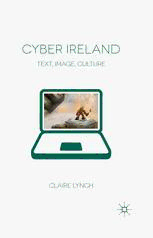
Cyber Ireland: Text, Image, Culture PDF
Preview Cyber Ireland: Text, Image, Culture
Cyber Ireland Text, Image, Culture CLAIRE LYNCH Cyber Ireland Cyber Ireland Text, Image, Culture Claire Lynch BrunelUniversityLondon,UK ©ClaireLynch2014 Softcover reprint of the hardcover 1st edition 2014 978-0-230-35817-1 Allrightsreserved.Noreproduction,copyortransmissionofthis publicationmaybemadewithoutwrittenpermission. Noportionofthispublicationmaybereproduced,copiedortransmitted savewithwrittenpermissionorinaccordancewiththeprovisionsofthe Copyright,DesignsandPatentsAct1988,orunderthetermsofanylicence permittinglimitedcopyingissuedbytheCopyrightLicensingAgency, SaffronHouse,6–10KirbyStreet,LondonEC1N8TS. Anypersonwhodoesanyunauthorizedactinrelationtothispublication maybeliabletocriminalprosecutionandcivilclaimsfordamages. Theauthorhasassertedherrighttobeidentifiedastheauthorofthiswork inaccordancewiththeCopyright,DesignsandPatentsAct1988. Firstpublished2014by PALGRAVEMACMILLAN PalgraveMacmillanintheUKisanimprintofMacmillanPublishersLimited, registeredinEngland,companynumber785998,ofHoundmills,Basingstoke, HampshireRG216XS. PalgraveMacmillanintheUSisadivisionofStMartin’sPressLLC, 175FifthAvenue,NewYork,NY10010. PalgraveMacmillanistheglobalacademicimprintoftheabovecompanies andhascompaniesandrepresentativesthroughouttheworld. Palgrave®andMacmillan®areregisteredtrademarksintheUnitedStates, theUnitedKingdom,Europeandothercountries. ISBN 978-1-349-34741-4 ISBN 978-1-137-38654-0 (eBook) DOI 10.1057/9781137386540 Thisbookisprintedonpapersuitableforrecyclingandmadefromfully managedandsustainedforestsources.Logging,pulpingandmanufacturing processesareexpectedtoconformtotheenvironmentalregulationsofthe countryoforigin. AcataloguerecordforthisbookisavailablefromtheBritishLibrary. LibraryofCongressCataloging-in-PublicationData Lynch,Claire,1981– CyberIreland:text,image,culture/ClaireLynch,BrunelUniversity,UK. pagescm Includesbibliographicalreferencesandindex. 1. Literatureandtechnology—Ireland—History—21stcentury. 2. LiteratureandtheInternet—Ireland. 3. Irishfiction—21stcentury— Historyandcriticism. 4. Englishfiction—Irishauthors—Historyand criticism—21stcentury. 5. Socialnetworks—Ireland. 6. Massmedia—Technologicalinnovations—Ireland. I. Title. PR8803.2L962014 820.9(cid:2)941509051—dc23 2014022093 For Bethan Contents ListofFigures viii Acknowledgements ix Introduction 1 1 OutWiththeOld,inWiththeBoring 16 2 LostinCyberspace 40 3 DiscoveringIreland 64 4 WhatCameFirst,theChickLitortheBlog? 91 5 TheDigitalDivide 116 6 GameOver 141 Bibliography 165 Index 174 vii Figures I.1 ‘DublinGoesDigital’,artworkbyCraigRobinson,on behalfofDDFH&BAdvertising 5 2.1 ‘I:Telemachus’Ulysses‘Seen’fortheiPad,artworkby RobertBerryonbehalfofThrowawayHorse,LLCwith BunsenTech,47 53 3.1 ‘TrinityCollegeatSunset’,artworkbyJohnMahonon behalfofDublinVirtuallyLive 70 3.2 ‘ViewfromO’ConnellBridge’,artworkbyJohnMahon onbehalfofDublinVirtuallyLive 73 6.1 ScreenshotfromTírNaNòg,permissionprovidedby GregFollisandRoyCarterofGargoyleGames. 146 6.2 MapofTírNaNòg,permissionprovidedbyGregFollis andRoyCarterofGargoyleGames 148 6.3 Kú‘TheJourneyBegins’,artworkbyBasilLimonbehalf ofbitSmithGames 151 viii Acknowledgements Many people have contributed to this book, by enthusiastically recommendingwebsitesorbooks,politelyenduringmyflightsoffancy and, most importantly, challenging me on whether the book should be written at all. Too numerous to name in person, this community of friends and colleagues helped to frame the ideas discussed here and Iamgratefultothem.Theopportunitytopresentthefirstiterationsat the 2009 IASIL conference at the University of Glasgow and, shortly afterwards, at the ‘Nations and Knowledges’ event for the Ireland– WalesNetworkatCardiffUniversitywasgenuinelyformative.Similarly important feedback grew out of discussions at the Conference of Irish Historians in Britain in 2012 at the University of York, with final ‘beta testing’ of the Cyber Ireland concept in 2013 at events at the Irish Cul- tural Centre in Hammersmith and University College Dublin. I am grateful to the organisers and fellow participants of all of these events fordevelopingandsupportingmythinkingonthesetopics. At Palgrave, my thanks go to Felicity Plester for getting the book startedandtoChrisPenfoldforgettingitfinished. Permissiontoreproducethecoverimage‘TheTáin’and‘TheJourney Begins’ from Kú © was kindly provided by artist Basil Lim of bitSmith Games. I am extremely grateful to the generous permission provided bythefollowing:‘DublinGoesDigital’©imagereproducedbypermis- sion of Craig Robinson, ‘I: Telemachus’ Ulysses ‘Seen’ © by permission of Robert Berry, ‘Trinity College at Sunset’ and ‘View from O’Connell Bridge’ © by permission of John Mahon and the image and map from Tír Na Nòg © by permission of Greg Follis and Roy Carter of Gargoyle Games. ix Introduction On30August2013,NobellaureateSeamusHeaneysentafinalmessage of comfort to his wife, Marie, urging her not to be afraid. A few days later, their son Michael shared these words with the congregation at Heaney’sfuneral,andthus,withtheworld’smedia.Fromthepulpitin Donnybrook,thetwo-wordtextmessagewasbeamedacrosstheglobe, re-emerging on the pages of newspapers and the cycling ticker-tape of 24-hour television news. But it was online, through social media, that the message really took flight. Concise and compelling, Heaney’s last words appeared in the world as a ready-made tweet, forwarded and shared between the computers and mobile phones of millions of peo- ple. In the days and weeks afterwards, passing on the private message became a public tribute to the poet and to poetry – an act of commu- nalcondolenceandvicariousstoicism.ThatHeaney’sfinalwordswere characteristically mighty was no cause for surprise; even so, a gentle rumbleofcuriositygatheredaroundthefactthatthe74-year-oldpoet’s last words had been transmitted by text message. The apparent con- trast between the new technology of the mobile phone and Heaney’s ‘belovedLatin’is,ofcourse,theverypoint–payinghomagetothepast whileretainingfaithinthefuture.ThewordsofHeaney’stextmessage were analysed and admired on blogs, news websites and social net- works,buttheywerealsoappropriated,takenupasanonlinebattlecry againstanyandallobstacles.Sendingandreceivingthetwowords‘noli timere’ allowed people to absorb Heaney’s imperative into their own devicesandlives,recyclingthemessageinactsofmemory,celebration and inspiration. These words are also the starting point here, because, in many ways, this is a book about fear and about not being afraid. Inthechaptersbelow,Iexploretheintersectionsbetweencyberculture and Irish literature, including the ways in which Irish writers have 1 2 CyberIreland started to engage with computer technology and the parallel impact that such technology has had on Irish writing. These are new areas of investigationand,assuch,theyprovokeanunderstandablefearofthe unknown. At the same time, this topic reveals numerous Irish writers, artists,programmersanddeveloperswhohaveshownthemselvestobe fearlessintheirengagementwithnewideasandnewopportunities. Context A few years ago, when I started to frame the ideas for this book, social networking,throughplatformssuchasFacebook,TwitterandLinkedIn, seemed to be revolutionising the way we thought of ourselves. Appar- ently transforming the very notion of identity and the ways in which we are involved in the lives of others, these online platforms are now ubiquitous to the point of passé. Considered ‘universal technologies’, users are as likely to be grandparents as teenagers, and online rituals such as ‘checking in’ at a location or updating one’s ‘status’ are now everyday activities for millions around the world. They are also, for many people, a matter of real concern. Marketed as an additional way tomaintainfriendshipsandprofessionalcontactsortosharenewsand entertainment,somecriticsareanxiousthat digital selves [have] become fractured, confused reflections of a per- son, never wholly unreal, but never wholly real either – a seeming half-truth. (Boon&Sinclair,2009,p.103) If social networks are sites of potential identity crisis, numerous other onlinetechnologieshavebecomeestablishedaspectsofdailylife,used to check the weather forecast, buy the groceries or find directions on a map. Indeed, there are people for whom the internet has already becomethedefaultsourceforentertainment,education,shoppingand sex. Whether one chooses to view this as a depressing dystopia or as exhilarating progress, it is impossible to deny technology’s ‘increas- ing embeddedness in everyday life’ (Bell, 2007, p.12). Responses to thesenewtechnologies,bothinthemediaandinscholarlydebate,are inevitablycouchedeitherinfear(wherewillitallend?)orinawe(how far can we go?); both are inspired by the shared sense that the ‘future’ is already here. Rather than waiting to see where technology leads us, of course, we might well begin by examining our initial uses of and reactions to the various phenomena we now think of as comprising
